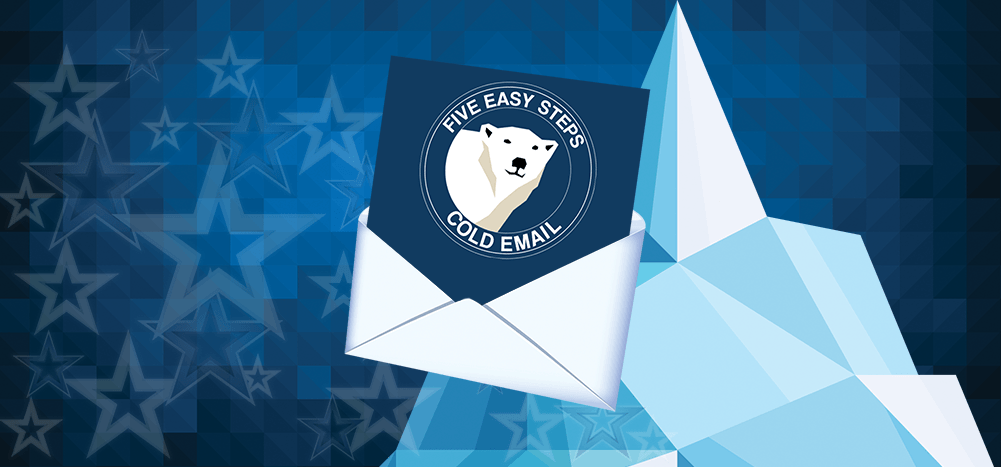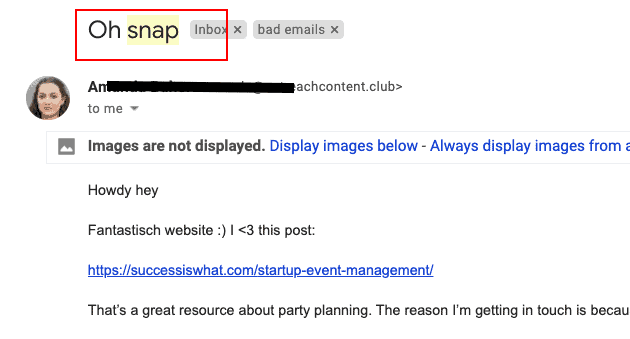
We need to make sure you know how to start a cold email.
Why? Because you know what everyone hates? Lazy cold emails.
You know the type. Those cookie-cutter emails that are lifted directly from templates.
They want to sell you something, and that’s all they focus on — you know because you’ve received tons of them.
And you can judge them by the first line alone.
Look, there’s nothing wrong with emailing someone cold. It’s a fantastic way to reach out to prospects at scale.
However, there’s a right way of doing it — cold email copywriting is an art, after all.
And acing the start of your cold email is an excellent place to begin.
So what do you do?
Step 1 of how to start a cold email: Establish your goals
Before you even begin writing your email, you need to clear up something very important:
What are you looking to accomplish with this cold email?
Is it selling a product or service?
Is it trying to build a relationship with someone?
Establishing this clear goal is vital, as it’s going to shape what your email looks like.
Remember, cold emails have very low reply rates.
And for good reason.
Your recipients are receiving an email from someone they don’t know.
Why should they bother with it?
To maximize your chances of getting noticed and receiving a reply, determine what you want your cold email to achieve and ensure that everything in your email contributes to this objective.
For example, if you’re sure the prospect is a qualified lead that really needs your product/service, consider including a pitch in your cold email.
You can then clearly describe what you’re offering to maximize your chances of getting a conversion.
However, if you’re unsure of this, leave out the pitch until you get a response from the recipient. Keep your first email centered around building a relationship with that prospect.
Naturally, this is going to result in a very different email.
As you’re not pitching something directly, you don’t need to detail what you’re offering and how it can benefit them. You can keep that for your next email once you’re sure that they’re a qualified lead.
Step 2 of starting your cold email: Get your subject line sorted out
Your “From” line is probably the first thing your recipients will notice.
But your subject line is a close second.
So pay special attention to getting it right, too.
And unfortunately, this can be trickier than it sounds!
Do NOT opt for gimmicky subject lines.
What do I mean by that?
I’m talking about adding multiple exclamation marks, using ALL CAPS, AlTeRnAtInG cApS, or words like “guaranteed” and “100%,” and so on.
And take a look at this subject line, for example:

Sure, you might open it out of curiosity, but it’s highly unlikely that you will take it seriously!
The body copy of the email that follows clearly shows that it’s lifted from a template.
Look, we’ve all received clickbait emails with subject lines like this in the past.
And what do most of us do the moment we see them?
Mark it as spam and send it straight to our trash.
Please don’t make the same mistake in your emails.
Opt for a fairly simple and short subject line that clearly expresses what your email contains and why it’s relevant to the recipient. Remember to include their name in your subject line to help it stand out among the sea of other generic cold emails they receive.
The moment someone sees their name, they believe that the email was tailor-made for them — increasing your email’s chances of getting opened.
If you want some examples of good email subject lines, here are 40+ subject lines you can start using right away.
Step 3 for starting a cold email: Ace your email greeting
Most people overlook how important email greetings are.
After all, it’s just a “hi” or “hello,” right?
How important could that be?
Well, as it turns out, it’s vital!
Remember, your greeting is still part of your email, and it sets the tone for the rest of your email.
Always try to address a recipient personally to stand out from the other generic cold emails they receive.
Don’t opt for a simple “Hi” or “Hello.”
If you know the name of the person you’re cold-emailing, take advantage of that.
Make it: “Hi Martin,” or “Hello Rebecca.”
It’s going to show them that this was an email specifically crafted for them — and they aren’t part of some massive email list receiving bland, mass emails.
If you’re looking for more insights on email greetings, check out my ultimate guide to email greetings.
Step 4 of opening a cold email: Establish how they got on your radar
Now you can actually start your cold email.
Finally!
Remember, your recipient doesn’t know who you are.
They haven’t interacted with you before.
So it makes sense for you to clarify why you’re emailing them.
Doing this is incredibly important as it’s going to show them that this wasn’t isn’t just a random cold email. There was a specific reason why you wanted to email them in particular.
An excellent way to do this is by complimenting/referencing something related to:
- Their achievements
- Their company
It’s a simple way to instantly build familiarity even though you’ve never interacted with them before. As you’re referencing something they did or are part of, you’ve established common ground and have a legitimate reason to reach out to them!
For example:
Hi Richard,
I recently read the insightful article you wrote about the future of e-commerce in PublicationX, and was blown away by your findings.
Why does this opening line work?
- It compliments them on something they did — and who doesn’t love compliments?
- It references something recent — which shows them that you’re genuinely interested in what they do.
By doing this, you’re not going to be viewed as a generic spammer who’s merely trying to sell them something.
You’re someone who’s fascinated by what they do and simply wanted to reach out.
But what if your cold email’s goal was to pitch to them? Should you still use this approach?
Yes!
Even if you’re planning to include a pitch in your cold email, never start with it.
Failing to establish a connection is a sure-fire way to let your recipients know that you don’t care about them — you only care about their money.
And that’s never a good idea!
Step 5 of how to start your email: Introduce yourself
Now that you’ve created some common ground, you can introduce yourself and why you’re emailing them.
When introducing yourself, try and connect it with whatever you referenced earlier to make it more meaningful.
Let’s build on the example I mentioned earlier:
Hi Richard,
I recently read the insightful article you wrote about the future of e-commerce on SiteX and was blown away by your findings.
My name is Ajay, and I’m the head of growth for e-commerce SiteY. I wanted to reach out to you because we collected some interesting data findings on customer behavior on our site, and I thought you’d be interested in it.
Why does this work?
- It plainly specifies who I am and what I do.
- It establishes a clear reason for contacting him.
Now that you’ve established who you are and why you’re emailing them, you’ve aced the start of your email!
How to start a cold email: Wrapping up
Starting cold emails can be tricky — but it isn’t impossible!
As long as you’re not overly promotional in your email’s introduction, you’ll have no trouble connecting with your email recipients. Additionally, always remember to personalize your cold emails to increase your chances of getting noticed.
And the easiest way to do this is by using GMass’ automatic personalization. GMass can automatically customize your subject lines, email greetings, and even your email body to save you the trouble of doing all this manually.
So why not sign up for GMass today to start your emails the right way and make your cold emails a success?
Send incredible emails & automations and avoid the spam folder — all in one powerful but easy-to-learn tool
TRY GMASS FOR FREE
Download Chrome extension - 30 second install!
No credit card required










